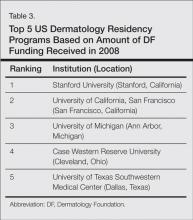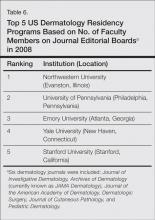US Dermatology Residency Program Rankings
Unlike many other adult specialties, US News & World Report does not rank dermatology residency programs annually. We conducted a study to rank individual US dermatology residency programs based on set criteria. For each residency program, data from 2008 related to a number of factors were collected, including annual amount of National Institutes of Health (NIH) and Dermatology Foundation (DF) funding received; number of publications from full-time faculty members; number of faculty lectures given at 5 annual society meetings; and number of full-time faculty members who were on the editorial boards of 6 dermatology journals with the highest impact factors. Most of the data were obtained through extensive Internet searches, and missing data were obtained by contacting individual residency programs. The programs were ranked based on the prior factors according to a weighted ranking algorithm. A list of overall rankings also was created.
Practice Points
- Dermatology is not among the many hospital-based adult specialties that are routinely ranked annually by US News & World Report.
- US dermatology residency programs were ranked based on various academic factors, including annual amount of National Institutes of Health and Dermatology Foundation funding received; number of publications from full-time faculty members; number of faculty lectures given at 5 annual society meetings; and number of full-time faculty members who were on the editorial boards of 6 dermatology journals with the highest impact factors.
Results
The overall ranking of the top 20 US dermatology residency programs in 2008 is presented in Table 1. The top 5 programs based on each of the 5 factors used in the weighted ranking algorithm are presented in Tables 2 through 6.
A separate analysis was performed to evaluate the relationship between the ranking factors and the size of the residency programs, as the data seemed to favor larger programs. Table 7 demonstrates that the amount of NIH and DF funding was positively correlated with the number of faculty members in a residency program. The remaining factors were not correlated with the number of faculty in the program.













